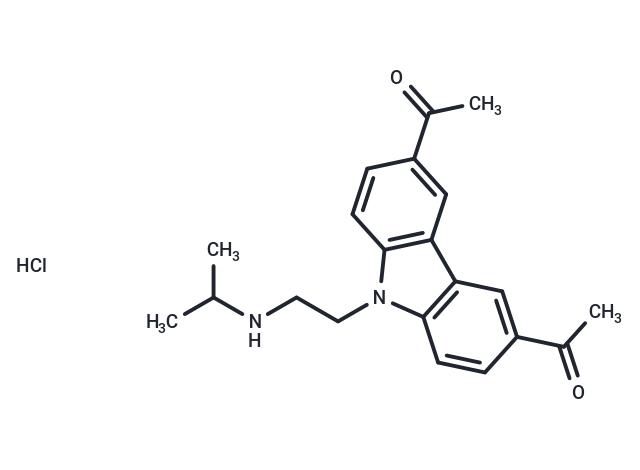Shopping Cart
- Remove All
 Your shopping cart is currently empty
Your shopping cart is currently empty

CBL0137 hydrochloride (Curaxin-137 hydrochloride) is an inhibitor of the histone chaperone FACT, which also activates p53 and inhibits NF-κB with EC50 values of 0.37 and 0.47 μM, respectively. CBL0137 hydrochloride functionally inactivates the complex that promotes chromatin transcription (FACT), thereby driving effects on p53 and NF-κB and promoting cancer cell death, and when used in combination with cisplatin, CBL0137 hydrochloride has potent anticancer activity against SCLC.

| Pack Size | Price | Availability | Quantity |
|---|---|---|---|
| 1 mg | 40 € | In Stock | |
| 5 mg | 124 € | In Stock | |
| 10 mg | 206 € | In Stock | |
| 25 mg | 414 € | In Stock | |
| 50 mg | 561 € | In Stock | |
| 100 mg | 747 € | In Stock | |
| 1 mL x 10 mM (in DMSO) | 102 € | In Stock |
| Description | CBL0137 hydrochloride (Curaxin-137 hydrochloride) is an inhibitor of the histone chaperone FACT, which also activates p53 and inhibits NF-κB with EC50 values of 0.37 and 0.47 μM, respectively. CBL0137 hydrochloride functionally inactivates the complex that promotes chromatin transcription (FACT), thereby driving effects on p53 and NF-κB and promoting cancer cell death, and when used in combination with cisplatin, CBL0137 hydrochloride has potent anticancer activity against SCLC. |
| Targets&IC50 | FACT:, p53:0.37 μM(EC50), NF-κB:0.47 μM(EC50) |
| In vitro | METHODS: HUVECs and HAECs cell treated with CBL0137 hydrochloride (Curaxin-137 hydrochloride) (0, 1, 3, 10 μM, 24 h) were tested for cell viability using the CCK-8 assay kit. RESULTS CBL0137 hydrochloride (Curaxin-137 hydrochloride) above 1 μM reduced the survival rate of HUVECs and HAECs. [1] |
| In vivo | METHODS: ApoE−/− mice were treated with CBL0137 hydrochloride (Curaxin-137 hydrochloride) (1 mg/kg, oral, for three weeks) to observe the effects of CBL0137 hydrochloride (Curaxin-137 hydrochloride) on the atherosclerosis mouse model and perform Western blot experiments. RESULTSCBL0137 hydrochloride (Curaxin-137 hydrochloride) can reduce the formation of atherosclerotic plaques in partially ligated carotid arteries;CBL0137 hydrochloride (Curaxin-137 hydrochloride) treatment downregulated the protein levels of p-YAP (Y357) and p-Src (Y416) in these arteries, as well as the inflammatory genes MCP-1 and VCAM-1. [1] |
| Kinase Assay | MiaPaca2 and BxPC-3 cells are treated with CBL0137 hydrochloride for 4 or 24 h. Cells are harvested in 1× Cell Culture Lysis Reagent containing protease and phosphatase inhibitors. Lysates 5 to 20 μg are separated on SDS-PAGE gels and transferred to PVDF membranes. Blots are probed with antibodies specific for SSRP1, SPT16, RRM1, and RRM2. |
| Cell Research | Effects of CBLC137 (2 μM for 24 hours) on cell cycle in tumor (HT1080, RCC45, MiaPaca) and normal cells (Wi38, NKE-hTERT) are examined using FACS analysis of propidium iodide-stained cells. |
| Animal Research | Animal Models: xenograft mouse models of cancer. Formulation: water. Dosages: 30 mg/kg. Administration: p.o. |
| Alias | Curaxin-137 hydrochloride, Curaxin 137 hydrochloride, CBL-C137 hydrochloride, CBLC137 hydrochloride |
| Molecular Weight | 372.88 |
| Formula | C21H25ClN2O2 |
| Cas No. | 1197397-89-9 |
| Smiles | Cl.CC(C)NCCn1c2ccc(cc2c2cc(ccc12)C(C)=O)C(C)=O |
| Relative Density. | no data available |
| Storage | Powder: -20°C for 3 years | In solvent: -80°C for 1 year | Shipping with blue ice. | ||||||||||||||||||||||||||||||
| Solubility Information | Ethanol: < 1 mg/mL (insoluble or slightly soluble) H2O: 25 mg/mL (67.05 mM), Sonication is recommended. DMSO: 36 mg/mL (96.55 mM), Sonication is recommended. | ||||||||||||||||||||||||||||||
Solution Preparation Table | |||||||||||||||||||||||||||||||
H2O/DMSO
| |||||||||||||||||||||||||||||||

Copyright © 2015-2025 TargetMol Chemicals Inc. All Rights Reserved.